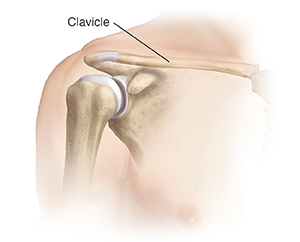A fracture of the clavicle is a broken collarbone. This bone runs horizontally from the shoulder blade to the top of the breastbone. Clavicle fractures occur most often along the middle of the bone. Less often, they occur at the ends of the bone. The bone may be cracked, or it may be broken into 2 or more pieces. The pieces may be lined up or they may have moved out of place. Sometimes, the bone may break through the skin. Depending on how badly the bone is broken, healing may take a few months or longer.
What causes a clavicle fracture?
Clavicle fractures are common, especially in children and teens. They are often caused from a blow to the shoulder. They can also be caused from a fall, accident, or sports injury.
Symptoms of a clavicle fracture
Symptoms can include:
-
Pain.
-
Swelling.
-
Bruising.
-
Bleeding, if the bone breaks through the skin.
-
Sagging of the shoulder.
-
Taut skin, deformity, or a bump that can be seen or felt where the bone is broken.
-
A grinding or crackling feeling when moving the shoulder.
-
Trouble moving or using the arm or shoulder.
-
Not using the arm completely (in young children).
Treating a clavicle fracture
Treatment depends on where the bone is broken and how serious the break is. If needed, the bone is put back into place. This may be done with or without surgery. If surgery is needed, the surgeon may use devices, such as pins, plates, or screws, to hold the bone together. You may need a sling or elastic bandage to keep the bone in place and protect it from injury during healing. Other treatments may also be used to help reduce symptoms or regain function. These include:
-
Cold packs. Putting an ice pack on the injured area may help reduce swelling, bruising, and pain.
-
Pain medicines. Prescription or over-the-counter pain medicines may help reduce pain and swelling.
-
Limits on activity. You may be told not to lift or drive or reach or pull until the bone has healed.
-
Exercises. You may be given certain exercises to do at home or with a physical therapist. These help improve strength, flexibility, and range of motion in the injured arm and shoulder.
Possible complications of a clavicle fracture
These can include:
-
Poor healing of the bone.
-
Bump that can be seen or felt even after the bone has healed.
-
Weakness, stiffness, or loss of range of motion in the arm and shoulder.
-
Osteoarthritis in the joints at either end.
When to call your doctor
Contact your health care provider right away if you have any of these:
-
A fever of 100.4°F (38°C) or higher, or as advised.
-
Chills.
-
Symptoms that don’t get better with treatment, or get worse.
-
Numbness, tingling, coldness, or swelling in your arm, hand, or fingers.
-
A sling that is damaged or feels too tight or loose.
-
Abnormal redness, warmth, swelling, bleeding, or drainage from any open wounds or incision sites.
-
New symptoms.
Author: Yang, Sue
© 2000-2025 The StayWell Company, LLC. All rights reserved. This information is not intended as a substitute for professional medical care. Always follow your healthcare professional's instructions.

